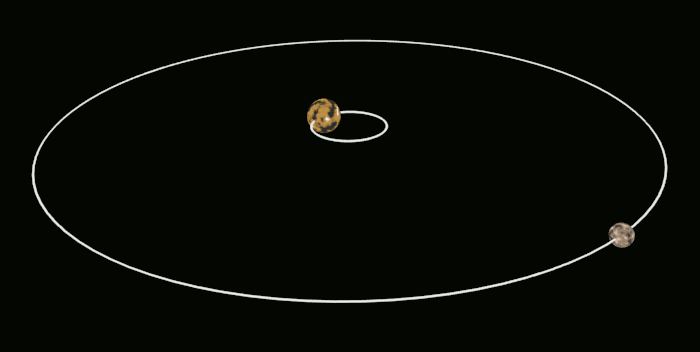The New Horizons spacecraft flies over Charon a Pluto Moon in 2015 July. The images recorded allowed for a digital reconstruction of much of Charon’s surface, further enabling the creation of fictitious flights over Charon created from this data.
Video credit: NASA, JHUAPL, SwRI, P. Schenk & J. Blackwell (LPI)
This minute-long, time-lapse video is shown with vertical heights and colors of surface features digitally enhanced. Your journey begins over a wide chasm that divides different types of Charon’s landscapes, a chasm that might have formed when Charon froze through.
You soon turn north and fly over a colorful depression dubbed Mordor that, one hypothesis holds, is an unusual remnant from an ancient impact. The voyage continues over an alien landscape rich with never-before-seen craters, mountains, and crevices.
The robotic New Horizons spacecraft has now been targeted at Kuiper Belt object 2014 MU 69, which it should zoom past on New Year’s Day 2019.
Charon, also known as (134340) Pluto I is the largest of the five known natural satellites of the dwarf planet Pluto. It was discovered in 1978 at the United States Naval Observatory in Washington, D.C., using photographic plates taken at the United States Naval Observatory Flagstaff Station (NOFS).
It is a very large moon in comparison to its parent body. Its gravitational influence is more powerful than that of Pluto. In September 2016, astronomers announced that the reddish-brown cap of the north pole of Charon is composed of tholins, organic macromolecules that may be essential ingredients of life.
Produced from methane, nitrogen and related gases released from the atmosphere of Pluto and transferred over about 19,000 km (12,000 mi) distance to the orbiting moon.
The New Horizons spacecraft is the only probe that has visited the Pluto system. It approached Charon to within 27,000 km (17,000 mi) in 2015.
Charon and Pluto orbit each other every 6.387 days. The two objects are gravitationally locked to one another, so each keeps the same face towards the other.
This is a case of mutual tidal locking, as compared to that of the Earth and the Moon, where the Moon always shows the same face to Earth, but not vice versa. The average distance between Charon and Pluto is 19,570 kilometers (12,160 mi). (See Below)
